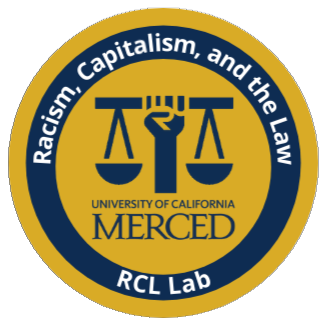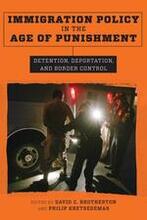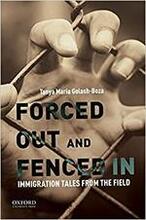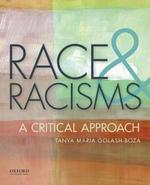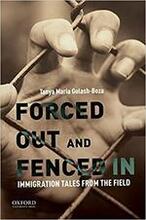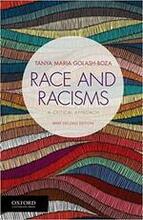Publications
2018
Former President Barack Obama’s administration oversaw three million deportations-far more than any previous President, and more than the sum total of all deportations prior to 1997. President Donald Trump has promised to surpass these record numbers of deportations. With mass deportation constantly in the news, students crave a deeper understanding of how we have arrived at this particular historical moment. This collection of powerful essays-written by leading scholars in migration studies-puts a human face on mass deportation by telling the stories of people bearing the brunt of immigration law enforcement. Each narrative in Forced Out and Fenced In: Immigration Tales From the Field centers on a person or a small group of people and places their story within the broader socio-legal and historical context. The authors weave the relevant historical, political, and socio-legal analysis throughout each essay, yet the narrative remains the most important element in each piece. The book is ideal for courses on immigration in sociology, anthropology, political science, law and society, ethnic studies, Latino studies, history, geography, and American studies.
This chapter analyses the experiences of isolation, precarity, and resilience of Dominican deportees. The context of reception of persons deported from the USA to Latin American and Caribbean countries is highly dependent on the cultural context and laws of each country. However, recent research has shown that deportees suffer isolation and stigmatisation that has clear effects on their social and labour market reintegration. This chapter, drawn from 46 interviews with Dominican deportees, explores how highly stigmatised individuals with minimal job experience find opportunities in the precarious and informal Dominican labour market. The ability of Dominican deportees to re-integrate is in part due to their ability to access the limited labour market opportunities, as well as through remittances from family members in the USA.
ace and Racisms: A Critical Approach engages students in significant questions related to racial dynamics in the U.S. and around the world. Written in accessible, straightforward language, the book discusses and critically analyzes cutting-edge scholarship in the field. Organized into topics and concepts rather than discrete racial groups, the text addresses: * How and when the idea of race was created and developed* How structural racism has worked historically to reproduce inequality* How we have a society rampant with racial inequality, even though most people do not consider themselves to be racist* How race, class, and gender work together to create inequality and identities* How immigration policy in the United States has been racialized* How racial justice could be imagined and realized Centrally focused on racial dynamics, Race and Racisms also incorporates an intersectional perspective, discussing the intersections of racism, patriarchy, and capitalism.
This chapter considers how biased policing practices, combined with institutional cooperation between immigration and criminal law enforcement agents, influences broader trends in deportation. Deportation laws in the United States are race- and gender-blind, but their implementation is not. Ninety-four per cent of interior removals involve men, even though women account for 47 per cent of unauthorized immigrants in the United States. And, 88 per cent of interior removals involve people from just four countries: Mexico, Guatemala, Honduras, and El Salvador, even though nationals from these countries only make up 66.3 per cent of unauthorized migrants. An analysis of how deportations happen that puts together on-the-ground practices of policing with immigration law enforcement cooperation helps us to understand these gendered and racialized patterns of deportation. This chapter draws from interviews with 117 deportees in the Dominican, Republic, Jamaica, and Guatemala in 2009 and 2010.
Research on undocumented students in the United States often focuses on the challenges they face navigating postsecondary education, rooted in their precarious legal status. The observed influence of legal status on undocumented students’ sense of belonging and academic progress provides compelling evidence that being undocumented functions as a master status – a salient identity that conditions students’ educational incorporation. Yet, this research tends to highlight legal status while deemphasizing or excluding other identities. Our study takes an intersectional approach. Using focus group data with undocumented students at a Hispanic-Serving Institution, we show that students rarely identify legal status in isolation or implicate it as the sole source of adversity. Instead, students’ reveal a sense of belonging rooted in multiple dimensions of identity including ethnicity and class. This study reconsiders the utility of the master status concept in favour of an intersectional one for a comprehensive picture of undocumented students’ educational incorporation.
This article draws from five focus groups with 35 undocumented students who enrolled in the University of California–Central (UC Central), a Hispanic Serving Institution (HSI) located in a Latino-majority, working-class community in the heart of the Central Valley, after the passage of the California Dream Act. We develop a framework of nested contexts of reception to argue that students encounter distinct contexts at the local, state, and federal levels that shape their educational incorporation. By considering nested contexts, we reveal how local, state, and federal policies and societal reception combine to help or hinder undocumented students’ success in higher education.
Ideal for instructors who want the flexibility to assign additional readings, Race and Racisms: A Critical Approach, Brief Second Edition, is a topical text that engages students in significant questions related to racial dynamics in the United States and around the world. Shorter than Golash-Boza’s highly acclaimed comprehensive text, the Brief Second Edition features a streamlined narrative and is enhanced by its own unique features. New to this Edition: Increased coverage of gender and intersectionality, including a new section on whiteness, class, gender, and sexuality New "Talking about Race" features in the front matter and at the end of each chapter New discussions of biology and ethnicity An expanded section on white privilege Coverage of racial justice social movements such as #OscarsSoWhite Updated "Thinking about Racial Justice" features, which encourage reflection and social involvement

